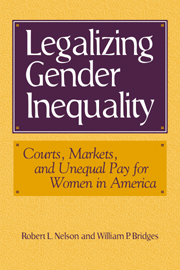Book contents
- Frontmatter
- Contents
- List of Figures and Tables
- Acknowledgments
- 1 Law, Markets, and the Institutional Construction of Gender Inequality in Pay
- Part I Theory and Method
- Part II The Case Studies
- Part III Conclusion: Legalizing Gender Inequality
- 9 Rethinking the Relationship between Law, Markets, and Gender Inequality in Organizations
- Appendix: Court Documents and Case Materials Used in Case Studies
- References
- Index
9 - Rethinking the Relationship between Law, Markets, and Gender Inequality in Organizations
Published online by Cambridge University Press: 07 August 2009
- Frontmatter
- Contents
- List of Figures and Tables
- Acknowledgments
- 1 Law, Markets, and the Institutional Construction of Gender Inequality in Pay
- Part I Theory and Method
- Part II The Case Studies
- Part III Conclusion: Legalizing Gender Inequality
- 9 Rethinking the Relationship between Law, Markets, and Gender Inequality in Organizations
- Appendix: Court Documents and Case Materials Used in Case Studies
- References
- Index
Summary
In an earlier era, the gendered division of labor was often seen as part of a natural order (Kessler-Harris 1982). Law was centrally implicated in this ideological structure. Not only did legal rules operate to constrain female labor force participation, but the opinions of judges articulated the gender ideology that made the rules reasonable and just. When the Supreme Court upheld the State of Illinois's proscription of women from law practice, it cited higher authority: “The paramount destiny and mission of woman are to fulfill the noble and benign offices of wife and mother. This is the law of the Creator.”
In the modern era, one would think, certainly both societal values about female employment and the role of the law in regulating labor markets have changed dramatically. A substantial proportion of American women work outside the home, even in years when they have young children. Now the law against employment discrimination stands to strike down the very sex stereotypes that it once invoked.
Yet what has changed? Women work, but, remarkably, they continue to “choose” jobs that pay less. According to orthodox labor economics, employing organizations are not responsible for this fact. The market sets the price of work independent of the gender of its incumbents. The highly gendered character of pay inequality in organizations is explained as the product of gender-neutral responses by employers to a gender-neutral labor market.
The market-based interpretation of gender inequality in organizations is not just one side of an academic debate.
- Type
- Chapter
- Information
- Legalizing Gender InequalityCourts, Markets and Unequal Pay for Women in America, pp. 309 - 364Publisher: Cambridge University PressPrint publication year: 1999



